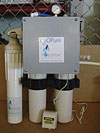
Reverse osmosis technology from GWC is designed to address water purity issues.
One of the most discussed and newly introduced methods of water purity concerns reverse osmosis (RO) that has found applications in commercial kitchens and bars, in HVAC evaporative coolers, and in office buildings as well as many other locales, according to Tom Cartwright, CEO of Good Water Co. (GWC) Inc., which has developed the PureOFlow reverse osmosis process.
“The new technology eliminates scaling and mineral build-up on ice machines,” he said. “This allows for the creation of pure, crystal-clear ice cubes, rather than ice laden with chlorine, salts, and other chemicals.
“It also reduces the need for descaling, keeping the machines functioning in peak condition. In most applications, the system pays for itself within six to 12 months of installation.”
In describing the process, he said, “Tap water passes through a series of membranes to reduce up to 98 percent of substances such as salts, arsenic, lead, and radium - particles as small as 1/1,000 the width of a human hair. The four-stage design uses a carbon pre-filter, two reverse osmosis-membrane elements developed by GE and ozone.”
By defintion, RO is “a separation process that uses pressure to force a solution through a semipermeable membrane that retains the solute on one side and allows the pure solvent to pass to the other side. More formally, it is the process of forcing a solvent from a region of high solute concentration through a membrane to a region of low solute concentration by applying a pressure in excess of the osmotic pressure.
“This is the reverse of the normal osmosis process, which is the natural movement of solvent from an area of low solute concentration, through a semipermeable membrane, to an area of high solute concentration when no external pressure is applied. The membrane here is semipermeable, meaning it allows the passage of solvent but not of solute.”
In the GWC approach, the carbon pre-filter removes sediment and chlorine, the two membrane elements are used for water separation, and the ozone keeps the water and equipment sanitary while ensuring the quality taste to the water.
In commercial system schematics from the company, the reverse osmosis system is shown in a separate location with lines extending to the equipment using water. For example, in commercial kitchens and bars, the system serves coffee makers, a soft drink dispenser, a dishwasher, and an ice maker. In the evaporative cooler configuration, lines run from the system to the coolers as well as a drinking water dispenser and a coffee maker. In the schematic example of an office, the system serves a drinking water dispenser, a coffee maker, and a humidifier.
Cartwright said the system is engineered to reduce the typical number of connection points by about one-half - “thus less chance of leaks.” There is also a quick-latch that “snaps into place and locks down all four tubing connectors in one step.”
He added, “The system never runs dry. Continuous permeate water flows at 1/2-gallon per minute. The manifolded system delivers 1 gallon per minute. The continuous flow means no storage tank is necessary.”
For more information, visit www.pureoflow.com/commercial.php.
Publication Date:10/06/2008


Report Abusive Comment